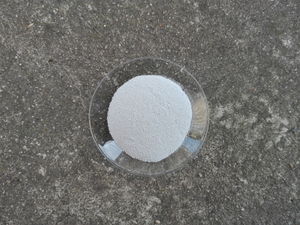Sodium hexafluoroaluminate
 Impure powdered cryolite, or "greyolite"
| |
| Names | |
|---|---|
| IUPAC name
Sodium hexafluoroaluminate
| |
| Other names
Cryolite
Kryolite Sodium aluminium hexafluoride Sodium fluoroaluminate Trisodium hexafluoroaluminate | |
| Properties | |
| Na3AlF6 | |
| Molar mass | 209.94 g/mol |
| Appearance | White solid |
| Odor | Odorless |
| Density | 2.9 g/cm3 |
| Melting point | 950 °C (1,740 °F; 1,220 K) |
| Boiling point | Decomposes |
| 0.042 g/100 ml (25 °C) | |
| Solubility | Insoluble in organic solvents |
| Vapor pressure | ~0 mmHg |
| Thermochemistry | |
| Std enthalpy of
formation (ΔfH |
-3,253.6 kJ/kmol[1] |
| Hazards | |
| Safety data sheet | Sigma-Aldrich |
| Flash point | Non-flammable |
| Lethal dose or concentration (LD, LC): | |
| LD50 (Median dose)
|
5,000 mg/kg (rat, oral) |
| Related compounds | |
| Related compounds
|
Sodium fluoride |
| Except where otherwise noted, data are given for materials in their standard state (at 25 °C [77 °F], 100 kPa). | |
| Infobox references | |
Sodium hexafluoroaluminate or sodium aluminium hexafluoride is the inorganic compound with the formula Na3AlF6. It occurs naturally as the mineral cryolite, which is also the more common name for this compound.
Contents
Properties
Chemical
Molten cryolite will dissolve aluminium oxide and the electrolysis of this mixture will give aluminium metal.
Cryolite is mostly inert to most reagents and oxidizers.
Physical
Sodium hexafluoroaluminate is a white solid, insoluble in water or other solvents.
Availability
Sodium hexafluoroaluminate is sold by various chemical suppliers. Can also be bought online.
Natural cryolite can be found in various parts of the world, such as Greenland or several US states.
Preparation
Cryolite is produced by reacting sodium hydroxide with aluminium oxide and hydrofluoric acid.
- 6 NaOH + Al2O3 + 12 HF → 2 Na3AlF6 + 9 H2O
Cryolite precipitates out of the solution, due to its very low solubility in water.
Projects
- Source of fluorides
- Make aluminium metal (Hall–Héroult process)
- Mineral collecting
Handling
Safety
Sodium hexafluoroaluminate has relative low toxicity. It is often used as roach killer.
Storage
Cryolite doesn't require special storage conditions. Any clean plastic bottle can be used as storage container.
Disposal
Cryolite doesn't require special disposal. Can be dumped in the trash.
References
- ↑ Sterten, A.; Maeland, I.; Acta Chemica Scandinavica, Series A: Physical and Inorganic Chemistry; vol. 39; (1985); p. 241 - 258